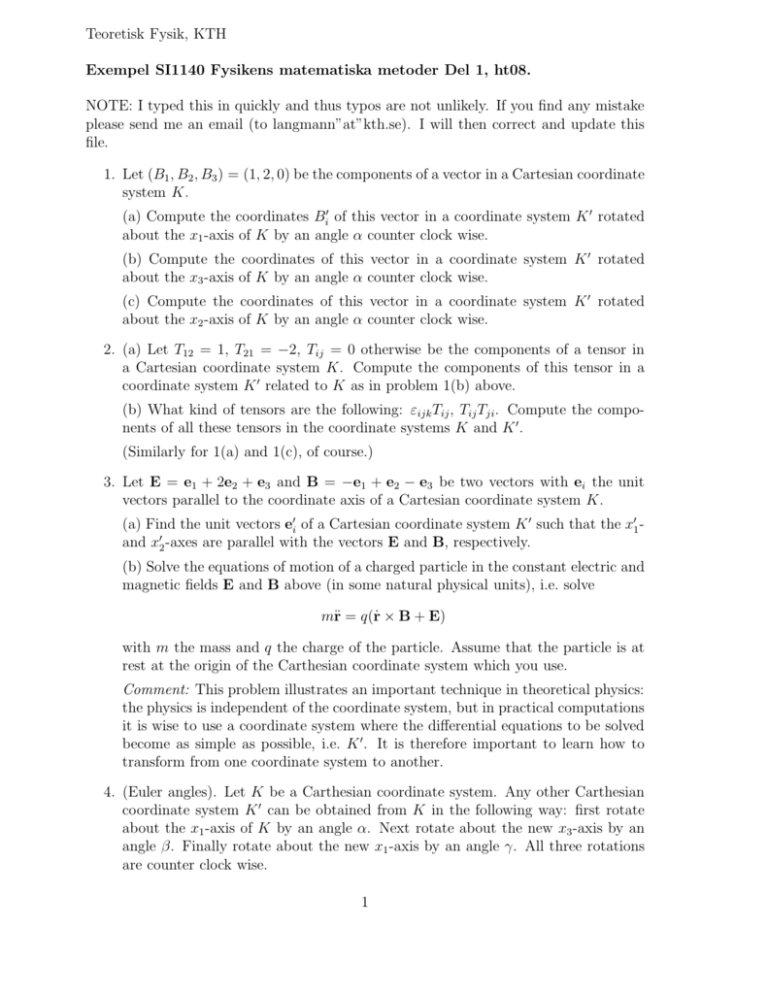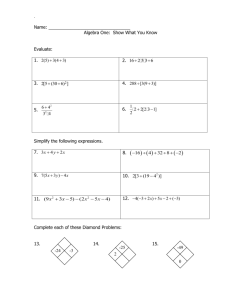Teoretisk Fysik, KTH Exempel SI1140 Fysikens matematiska
advertisement

Teoretisk Fysik, KTH Exempel SI1140 Fysikens matematiska metoder Del 1, ht08. NOTE: I typed this in quickly and thus typos are not unlikely. If you find any mistake please send me an email (to langmann”at”kth.se). I will then correct and update this file. 1. Let (B1 , B2 , B3 ) = (1, 2, 0) be the components of a vector in a Cartesian coordinate system K. (a) Compute the coordinates Bi′ of this vector in a coordinate system K ′ rotated about the x1 -axis of K by an angle α counter clock wise. (b) Compute the coordinates of this vector in a coordinate system K ′ rotated about the x3 -axis of K by an angle α counter clock wise. (c) Compute the coordinates of this vector in a coordinate system K ′ rotated about the x2 -axis of K by an angle α counter clock wise. 2. (a) Let T12 = 1, T21 = −2, Tij = 0 otherwise be the components of a tensor in a Cartesian coordinate system K. Compute the components of this tensor in a coordinate system K ′ related to K as in problem 1(b) above. (b) What kind of tensors are the following: εijk Tij , Tij Tji . Compute the components of all these tensors in the coordinate systems K and K ′ . (Similarly for 1(a) and 1(c), of course.) 3. Let E = e1 + 2e2 + e3 and B = −e1 + e2 − e3 be two vectors with ei the unit vectors parallel to the coordinate axis of a Cartesian coordinate system K. (a) Find the unit vectors e′i of a Cartesian coordinate system K ′ such that the x′1 and x′2 -axes are parallel with the vectors E and B, respectively. (b) Solve the equations of motion of a charged particle in the constant electric and magnetic fields E and B above (in some natural physical units), i.e. solve mr̈ = q(ṙ × B + E) with m the mass and q the charge of the particle. Assume that the particle is at rest at the origin of the Carthesian coordinate system which you use. Comment: This problem illustrates an important technique in theoretical physics: the physics is independent of the coordinate system, but in practical computations it is wise to use a coordinate system where the differential equations to be solved become as simple as possible, i.e. K ′ . It is therefore important to learn how to transform from one coordinate system to another. 4. (Euler angles). Let K be a Carthesian coordinate system. Any other Carthesian coordinate system K ′ can be obtained from K in the following way: first rotate about the x1 -axis of K by an angle α. Next rotate about the new x3 -axis by an angle β. Finally rotate about the new x1 -axis by an angle γ. All three rotations are counter clock wise. 1 Derive the transformation matrix Lij transforming from K to K ′ as described above. Comments: You can find the answer to this problem in Wikipedia.1 Euler angles play an important role in mechanics. 5. Find the potential generated by a charge Q in three dimensional space R3 and vanishing at spatial infinity. Hints: Introduce a coordinate system such that the charge is in the origin r = 0 and solve ∆Φ(r) = −Qδ 3 (r). in spherical coordinates and for r > 0, assuming that the potential φ only depends on r = |r|. To fix the constant integrate the Poisson equation over some convenient volume containing the origin and use Gauss’ theorem. 6. Find the potential generated by a charge Q in two dimensional space R2 and vanishing at the distance R > 0 from the charge. Hints: Similar as the previous problem but with polar coordinates. 7. Find the spherical symmetric solution of (−∆ + m2 )Φ(r) = Qδ 3 (r). in R3 which vanishes at spatial infinity. 1 http://en.wikipedia.org/wiki/Euler angles 2







